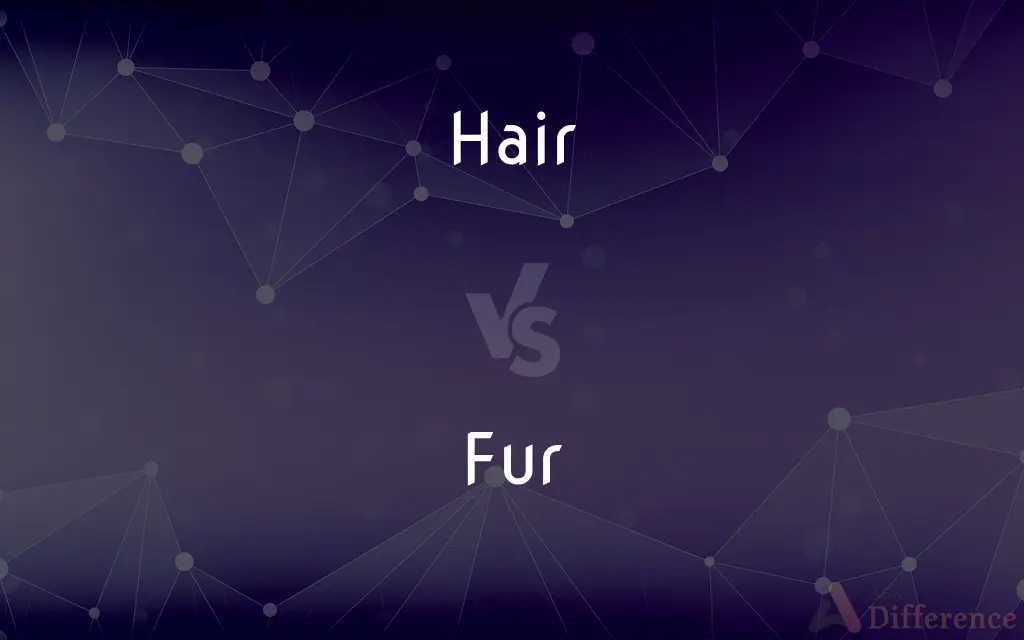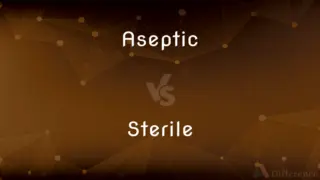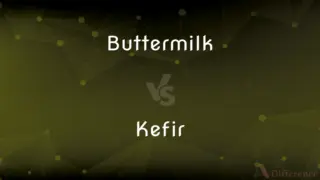Hair vs. Fur — What's the Difference?
By Maham Liaqat & Urooj Arif — Updated on March 21, 2024
Hair and fur are both made of keratin, but hair is usually longer and found on humans, while fur is denser, shorter, and on animals.

Difference Between Hair and Fur
Table of Contents
ADVERTISEMENT
Key Differences
Hair primarily grows on humans, covering most of the body except for the palms, soles, and mucous membranes. It varies greatly in length, color, and texture among individuals and races. Fur, on the other hand, refers to the thick coat of hair that covers the skin of many animals. It is generally shorter, denser, and softer than human hair. Fur serves primarily for thermal insulation, protecting animals from cold by trapping air and reducing heat loss. In addition, fur coloration can serve for camouflage, signaling, or as part of an animal's mating strategy.
Hair plays a significant role in regulating body temperature and facilitating evaporation of sweat. It also has considerable social and cultural significance, often associated with beauty, status, or personal identity. Unlike human hair, fur often goes through seasonal changes, shedding, and regrowth to adapt to different climate conditions.
In humans, hair can grow long and is often subject to various grooming styles, whereas animals with fur typically have a consistent coat that undergoes molting. Hair grooming is a significant cultural practice among humans, with a vast industry dedicated to hair care products and services. Fur, while requiring some maintenance in domesticated animals, is largely self-regulating in the wild.
Hair growth in humans is continuous and can be cut or styled without affecting its ability to grow back. Animal fur, however, has a growth cycle that includes phases of growth, rest, and shedding. This cycle is crucial for the animal's adaptation to its environment, allowing for thicker coats in the winter and lighter ones in the summer.
Another difference lies in the uses of hair and fur by humans. Human hair is often collected and used in wigs, extensions, and even in art. Animal fur, however, has been used historically for clothing, warmth, and as a status symbol. The ethical concerns surrounding the use of animal fur for clothing and other purposes have led to significant debate and shifts towards synthetic alternatives.
ADVERTISEMENT
Comparison Chart
Location
Primarily on humans
On animals
Function
Temperature regulation, social significance
Thermal insulation, protection, camouflage
Growth Cycle
Continuous growth
Seasonal shedding and regrowth
Grooming
Subject to styles, significant industry
Self-regulating, some maintenance required
Uses by Humans
Wigs, extensions, art
Clothing, warmth, status symbol
Compare with Definitions
Hair
The hair that grows on the scalp of humans.
He decided to dye his head hair blue for the summer.
Fur
The thick coat of soft hair covering the skin of certain animals.
The rabbit's fur was incredibly soft to the touch.
Hair
Hair that grows on the face, typically found in males.
He grew his facial hair out to sport a beard.
Fur
The dense, soft layer of fur beneath the guard hairs.
The undercoat keeps the animal warm in cold temperatures.
Hair
Hair that grows on parts of the body other than the scalp.
Body hair can vary widely in thickness and length among different people.
Fur
The longer, coarser hairs in an animal's fur that provide protection.
The guard hairs protect the undercoat from getting wet.
Hair
Hair that grows in the genital area during puberty.
Pubic hair is considered a secondary gender characteristic.
Fur
The complete coat of fur on an animal.
The lynx's pelage changes color with the seasons.
Hair
The strands of keratin that grow from the skin of humans and some animals.
She brushed her long, silky hair every morning.
Fur
The shedding of fur to allow new growth.
The dog began to molt as the weather warmed up.
Hair
Hair is a protein filament that grows from follicles found in the dermis. Hair is one of the defining characteristics of mammals.
Fur
Fur is a thick growth of hair that covers the skin of many different animals, particularly mammals. It consists of a combination of oily guard hair on top and thick underfur beneath.
Hair
Any of the fine threadlike strands growing from the skin of humans, mammals, and some other animals
Thick black hairs on his huge arms
Coarse outer hairs overlie the thick underfur
Fur
A member of a Muslim people of the mountainous and desert regions of south-western Sudan.
Hair
Hairs collectively, especially those growing on a person's head
Her shoulder-length fair hair
Fur
The language of the Fur, an isolated member of the Nilo-Saharan family, with about 500,000 speakers.
Hair
A very small quantity or extent
His magic takes him a hair above the competition
Fur
Coat or clog with a deposit
The stuff that furs up coronary arteries
Hair
Any of the cylindrical, keratinized, often pigmented filaments characteristically growing from the epidermis of a mammal.
Fur
Covered with or made from a particular type of fur
The black-furred rabbit
Hair
A growth of such filaments, as that forming the coat of an animal or covering the scalp of a human.
Fur
Level (floor or wall timbers) by inserting strips of wood
The drain could be concealed by furring out the original wall
Hair
A filamentous projection or bristle similar to a hair, such as a seta of an arthropod or an epidermal process of a plant.
Fur
Relating to the Fur or their language.
Hair
Fabric made from the hair of certain animals
A coat of alpaca hair.
Fur
The thick coat of soft hair covering the skin of certain mammals.
Hair
A minute distance or narrow margin
Won by a hair.
Fur
The hair-covered, dressed pelt of such a mammal, used in making garments and as trimming or decoration.
Hair
A precise or exact degree
Calibrated to a hair.
Fur
A garment made of or lined with the dressed pelt of a mammal.
Hair
(countable) A pigmented filament of keratin which grows from a follicle on the skin of humans and other mammals.
Fur
See fake fur.
Hair
(uncountable) The collection or mass of such growths growing from the skin of humans and animals, and forming a covering for a part of the head or for any part or the whole body.
In the western world, women usually have long hair while men usually have short hair.
Fur
A furlike coating
Fur on the tongue.
Hair
A slender outgrowth from the chitinous cuticle of insects, spiders, crustaceans, and other invertebrates. Such hairs are totally unlike those of vertebrates in structure, composition, and mode of growth.
Fur
To cover, line, or trim with fur.
Hair
A cellular outgrowth of the epidermis, consisting of one or of several cells, whether pointed, hooked, knobbed, or stellated.
Internal hairs occur in the flower stalk of the yellow frog lily (Nuphar).
Fur
To cover or coat as if with fur.
Hair
(countable) Any slender, flexible outgrowth, filament, or fiber growing or projecting from the surface of an object or organism.
Fur
To line (a wall or floor) with furring.
Hair
A locking spring or other safety device in the lock of a rifle, etc., capable of being released by a slight pressure on a hair-trigger.
Fur
The hairy coat of various mammal species, especially when fine, soft and thick.
Hair
(obsolete) Haircloth; a hair shirt.
Fur
The hairy skin of an animal processed into clothing for humans.
Hair
(countable) Any very small distance, or degree; a hairbreadth.
Just a little louder please—turn that knob a hair to the right.
Fur
A pelt used to make, trim or line clothing apparel.
Hair
Complexity; difficulty; the quality of being hairy.
Fur
A coating, lining resembling fur in function and/or appearance.
Hair
(transitive) To remove the hair from.
Fur
A thick pile of fabric.
Hair
(intransitive) To grow hair (where there was a bald spot).
Fur
The soft, downy covering on the skin of a peach.
Hair
(transitive) To cause to have or bear hair; to provide with hair
Fur
The deposit formed on the interior of boilers and other vessels by hard water.
Hair
To string the bow for a violin.
Fur
The layer of epithelial debris on a tongue.
Hair
The collection or mass of filaments growing from the skin of an animal, and forming a covering for a part of the head or for any part or the whole of the body.
Fur
(heraldry) One of several patterns or diapers used as tinctures.
Hair
One the above-mentioned filaments, consisting, in vertebrate animals, of a long, tubular part which is free and flexible, and a bulbous root imbedded in the skin.
Then read he me how Sampson lost his hairs.
And draweth new delights with hoary hairs.
Fur
Rabbits and hares, as opposed to partridges and pheasants (called feathers).
Hair
Hair (human or animal) used for various purposes; as, hair for stuffing cushions.
Fur
A furry; a member of the furry subculture.
Hair
A slender outgrowth from the chitinous cuticle of insects, spiders, crustaceans, and other invertebrates. Such hairs are totally unlike those of vertebrates in structure, composition, and mode of growth.
Fur
Pubic hair.
Hair
An outgrowth of the epidermis, consisting of one or of several cells, whether pointed, hooked, knobbed, or stellated. Internal hairs occur in the flower stalk of the yellow frog lily (Nuphar).
Fur
(transitive) To cover with fur or a fur-like coating.
Hair
A spring device used in a hair-trigger firearm.
Fur
(intransitive) To become covered with fur or a fur-like coating.
Hair
A haircloth.
Fur
To level a surface by applying furring to it.
Hair
Any very small distance, or degree; a hairbreadth.
Fur
Pronunciation spelling of for
Hair
Dense growth of hairs covering the body or parts of it (as on the human head); helps prevent heat loss;
He combed his hair
Fur
The short, fine, soft hair of certain animals, growing thick on the skin, and distinguished from the hair, which is longer and coarser.
Hair
A very small distance or space;
They escaped by a hair's-breadth
They lost the election by a whisker
Fur
The skins of certain wild animals with the fur; peltry; as, a cargo of furs.
Hair
Filamentous hairlike growth on a plant;
Peach fuzz
Fur
Strips of dressed skins with fur, used on garments for warmth or for ornament.
Hair
Any of the cylindrical filaments characteristically growing from the epidermis of a mammal;
There is a hair in my soup
Fur
Articles of clothing made of fur; as, a set of furs for a lady (a collar, tippet, or cape, muff, etc.).
Wrapped up in my furs.
Hair
Cloth woven from horsehair or camelhair; used for upholstery or stiffening in garments
Fur
Any coating considered as resembling fur
Hair
A filamentous projection or process on an organism
Fur
One of several patterns or diapers used as tinctures. There are nine in all, or, according to some writers, only six.
Fur
Of or pertaining to furs; bearing or made of fur; as, a fur cap; the fur trade.
Fur
To line, face, or cover with fur; as, furred robes.
Fur
To cover with morbid matter, as the tongue.
Fur
To nail small strips of board or larger scantling upon, in order to make a level surface for lathing or boarding, or to provide for a space or interval back of the plastered or boarded surface, as inside an outer wall, by way of protection against damp.
Fur
The dressed hairy coat of a mammal
Fur
Dense coat of fine silky hairs on mammals (e.g., cat or seal or weasel)
Fur
A garment made of fur
Common Curiosities
Do all animals with fur shed?
Most animals with fur go through some form of shedding or molting.
Is fur only found on mammals?
Yes, fur is a characteristic feature of mammals.
Why do humans groom their hair?
Hair grooming in humans serves aesthetic, hygienic, and cultural purposes.
What is the purpose of guard hairs in animals?
Guard hairs protect the undercoat and skin from moisture and damage.
Why is fur a status symbol?
Historically, fur signified wealth and status due to its rarity and cost.
Can humans have fur?
Technically, the term "fur" is not used for humans, even though human hair shares the same basic composition.
How does human hair differ in its growth cycle from animal fur?
Human hair grows continuously, while animal fur goes through cycles of growth and shedding.
Are hair and fur composed of the same materials?
Yes, both are made of keratin.
Why do animals have fur?
Fur provides insulation against the cold, protection, and sometimes camouflage.
Can fur be ethical?
The ethics of using fur depend on sourcing, with synthetic alternatives being preferred for ethical reasons.
Is it possible to dye fur like human hair?
While technically possible, dying an animal's fur is generally discouraged due to potential harm.
What are some uses of human hair?
Human hair is used in wigs, extensions, and sometimes in art.
How do seasonal changes affect animal fur?
Animals often grow thicker fur in the winter for insulation and shed in the summer.
How do grooming practices differ between humans and animals?
Humans actively groom their hair, while animals rely more on natural processes with some assistance for pets.
What are the alternatives to natural fur?
Synthetic fibers and faux fur are popular ethical and environmentally friendly alternatives.
Share Your Discovery

Previous Comparison
Aseptic vs. Sterile
Next Comparison
Buttermilk vs. KefirAuthor Spotlight
Written by
Maham LiaqatCo-written by
Urooj ArifUrooj is a skilled content writer at Ask Difference, known for her exceptional ability to simplify complex topics into engaging and informative content. With a passion for research and a flair for clear, concise writing, she consistently delivers articles that resonate with our diverse audience.














































